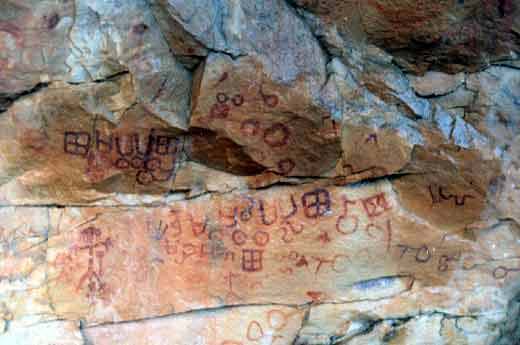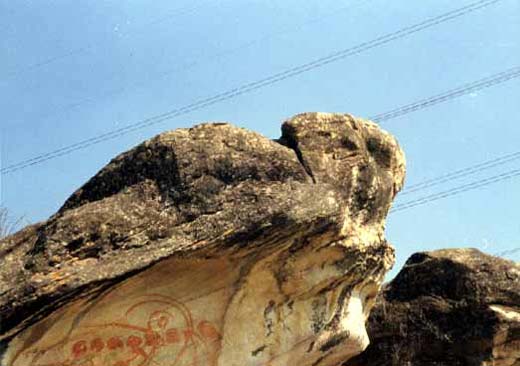ROCK ART
HERITAGE OF INDIA (Unpublished)
by Dr. Gautam
Chatterjee

Whose hands fashioned these
vibrant images on rock surfaces ages ago, and why? Perhaps we may never
fully discover the unknown artist’s identity or the impulse behind his art.
Perhaps he was a great hunter, a chieftain or just the prehistoric man. Rock
art are mixture of aesthetics, the then records and philosophy! Thus in
unraveling mankind’s evolution from homo errect us to homo sapiens, these
early images offer vital but very perplexing clues. Rock art is universal
heritage which is an in-built logical relevancy of this art by a method,
explained by a noted Anthropologist Prof. Saraswati, ‘diachronic
hermeneutics which is threefold. First, enter into the present context of
traditional arts; second, move backward in time to rock art; and third,
construct a dialogical frame in which the visual text and the traditional
context are compared...all these go for making a pluralistic world view to
realize the cosmic dimension of rock art’.
Early man started drawing on
the walls some 40000 years ago B. P. (Before Present) during the Upper
Paleolithic era. Nevertheless cultural traits perhaps continued even into
the following Mesolithic Age 12,000 to 10000 B.P.In this era ancient man
domesticated animals and expanded his activities. In the Neolithic Age
(8000-6000 BP) The final prehistoric phase dawned with the discovery of
copper during the Chalcolithic era(6000-5000 BP). These are the broad
prehistoric periods during which rock arts are found in abundance worldwide.

There are three kinds of rock
arts--rock paintings, rock engravinga and rock brushings. Noted Rock Art
expert Erwin Neumayer wrote ‘The touch glass surface of the quartizite,
whose colours range from white shades to red, depending on the mineral
context, in the best canvas for pictures in the mineral pigments’.
India has the third largest
concentration of rock art, after Australia and Africa. Prof.S.Malik a
Cultural Anthoropologist said ‘Of the over one million motifs,animals are
the most frequent,humans come next, and symbols and designs third in their
order of occurrence.’
The search of Indian Rock Art
sites started in 1856 when the first Petroglyphs were reportedly discovered
in Almora. In Mirzapur district of Uttar Pradesh Archibald Carlleyle, First
Assistant in the Archeological Office of British Indian Government
discovered rock art sites. However, the present map of rock art sites were
mainly discovered in the late 20th century. However, there are many rock art
sites available in remotest places hidden beneath dense of woods or
inaccessible mountainous terrain.
V.S.Wakankar recorded that
there are some 754 rock shelters in and around Bhimbetka. In the Betwa
region some 157 rock shelters are found which are recorded by ‘Rock Art in
India’ by K.K. Chakravarty and Shankar Tiwari. In Mrizapur there are around
250 rock shelters. Prof. Mathpal found many sites in Uttarakhand especially
in the Kumaon areas.There are around sixty-eight sites have been found in
this region. In Orissa in the western districts of Sambalpur,S undergarh
etc. one can find rock art sites which is found in extension in the
Chottanagpur and Chhattisgarh.

Prof Mirta in Prehistoric
India said that in Bihar, rock paintings were reported in the Kaimur range,
Patesar, Jhania Pahar etc. Rock engravings are found in Singhbhum district.
In the western India Gujarat
remains the rich in rock art sites. The sites are hemmed in Baroda,
Bhavnagar districts and alongside the Aravalli range. In Maharastra Inamgaon,
Chandrapur and in Nasik one can find rock art sites. In deep south one can
find rock art sites in various places in Tamilnadu, Kerala, Karnataka.
Even rock art sites are
reported in the north-eastern belt of Garo hills of Assam, Bengal, Manipur
etc. Similarly in the northern most India rock art sites and petroglyphs are
found in Leh, Kargil, Dras in Ladak. Thus we find with a pessimistic survey
the whole India is carrying the heritage of rock arts which are a rare book
of knowledge of the days of antiquity.
The primitive artist
primarily used mineral and vegetable colour. Moreover various pigments were
used like hematite and other oxide to derive red, yellow orange and brown.
In some rock arts one can find deeper colours which were obtained from
oxides of magnesium. Prof. Malik referred that in the Bhimbetka Rock Art
sites one can find some twenty one colours namely white, ashy white, creamy
white, yellow, yellow ochre, raw sienna, raw umber, orange, dark orange,
vermilion, scarlet, burnt sienna, emerald green, black crimson , crimson
lake and purple etc.

Human artistry heritage since
hoary past remained a parallel endeavour beyond time and space. The most
primitive men of even today carry out their endeavour around their shelters.
If one has a close look at the Worli houses one finds the motifs of sun and
moon and also the stick man concepts which we find in historic and
pre-historic rock art sites.
Similarly, most primitive
culture kept their aesthetic talent intact without allowing any interference
from the so called ‘progressive world’.
Prof. Malik in an article
explained the context of cultural proximity between ancient rock art sites
and traditional people of the present era. He said ‘...the fundamental art
tradition persists by way of contemporary ‘folk’ and ‘tribal’ in oral ways,
such as amongst the Warlis, Santhals, the Gonds and so on. In short Rock art
may be seen as a part of a living tradition, in terms of local histories and
in the understanding of the psychology and history of humankind. It is the
universality of the medium and the message within this global creative urge
that holistic thinking and alternate methodologies may emerge’.
After understanding the
‘cultural proximity and continuum’ let us try to delve into the motifs of
rock art sites which not only gives a pictorial reference of the then times
but also tries to record ‘the thought of the upper mind’ as well.
For prehistoric man,
existence was marked by a struggle for survival in a largely hostile world.
During the Ice Age, the animal population was greater and men were forced to
live together in small groups. Life was conditioned by the search for food,
entailed a daily struggle against the little known and largely controllable
aspects of nature. Archaeological findings about pre-historic man, do tell
us the then world of animals and human endeavour be it hunting or attacking
some animal etc. Apart from hunting, there are evidences of dancing
alongside with symbolic musical instruments etc.
In Indian rock art one can
see spiritual movements of triangles, circles and Suns and Moons. The
symbolism of ‘Shakti’ or mother concept is also found in the Paleolithic
shelters of 10000 year old. Moreover, the cosmic context is explained in a
Jaora rock art where fish, lotus stems, flying birds etc are see.
On the human angle one can
seat Karnataka the courting human being, men at war or a procession or
ceremonial walk etc. In Chatraubhujanath Nala,in Madhya pradesh one can find
bullock-carts or chariots are found.
Another dominating motif of
Indian rock art is deer which are drawn mainly X ray style. Yet, most
portrayals did not reveal perfect anatomical positions. However according to
Neumayer, the most accurate X ray painting is in Kathoti a where the deer’s
digestive tract contains fodder in the stomach. Yet, deer with beautiful
geometrical body decorations are also abundant. Rock art in Mrzapur, depicts
the deer in a non-naturalistic style, in different postures and scenes.
Indian Rock art, thus, give
tremendous clues to understand the then era be it their life-style,
entertainment or the mysticism. The detailed concepts of animals from
‘filled’ types to ‘stick’ and ‘x-ray’ types are found in abundance which are
some time parallel to the universal movement of rock arts. One can find
animal motifs of different kind which are today extinct. I recall, having
seen rhino in the Rock Art sites of Son Bhadra which cannot be found today.
There are ample references of weapons and head-gears including
‘hunting’masks of animal kind. These are drawn in varied colour temperatures
and depict various horizons of aesthetic endeavour. There are many motifs
which are overlapped with other era drawings. Thus finding and accurately
dating each motif or symbol is not possible. But they remain a vibrant
collage of the then era. Rock Art heritage of India, remains an infant as
per recording and ‘rediscovery’ of sites go. Yet, they project, an ample
scope to invite tourists from world over to witness the then era of
prehistoric kind. Sordidly enough none of the Rock Art sites have been
incorporated into the Tourist Map of India but if those sites are maintained
and preserved as ‘ heritage parks’ then the world would be able to read the
open aesthetically created ‘dossiers’ of our ancestors!